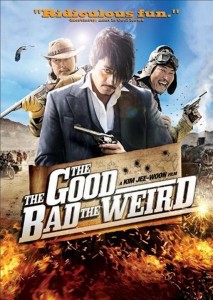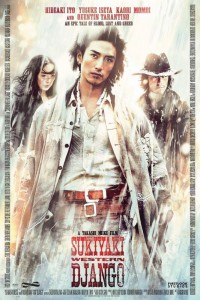The Film Vault is a monthly feature designed to showcase critically-acclaimed films that had limited commercial release and/or success. Each feature highlights films that focus on a specific theme, genre, or technique designed to provide a greater understanding of film as an entertainment and art form.
It has been a busy week on the indie movie scene, with the release of the Cannes line up for 2011 (available here with summary) featuring a strong showing by many well-known and well-received directors. What better time to fire up the Queue and see what is lurking in the shadows?
This month’s selection takes us to Japan and Korea for mash-ups of samurai flicks and old-school westerns. For both featured directors, these films are a bit of a departure from their typical fare. Both are known in the Asian horror circuit as visionary directors, but have not received much recognition stateside even within that genre. These projects fall closer to the subjects of traditional film as opposed to the more supernatural nature of their other works.
THE GOOD, THE BAD, THE WEIRD (2008)
Director: Kim Ji Woon
Trailer: http://www.youtube.com/watch?v=Zjm9gAjgRuU
Making a play on the title of the Sergio Leone-Clint Eastwood classic “The Good, The Bad, and The Ugly,” Woon re-envisions the classic film over a 1940’s Japanese backdrop. The resulting combination of soaring visuals, non-stop action, and fantastic acting breathes life back into the Western genre.
Three Korean gunslingers find themselves in Manchuria circa World War II, including Do-wan, an upright bounty hunter, Chang-yi, a thin-skinned and ruthless killer, and Tae-goo, a train robber with nine lives. Tae-goo finds a map he’s convinced leads to buried treasure, and Chang-yi wants it as well for less clear reasons. Do-wan tracks the map, knowing it will bring him to Chang-yi, Tae-goo, and reward money. Occupying Japanese forces and their Manchurian collaborators also want the map, as does the Ghost Market Gang who hang out at a thieves’ bazaar. These enemies cross paths frequently and dead bodies pile up. Will anyone find the map’s destination and survive to tell the tale? (Written by jhailey@hotmail.com)
In a step away from the usual cerebral musings of the Queue, this film is less interested in introspective character development and more interested in blowing things up—lots and lots of blowing things up, with splashes of comedy throughout. The three main characters are all played by veteran Asian actors (you know Byung-hun Lee—the titular “Bad”—as Storm Shadow from the “G.I. Joe” re-boot) whose expertise shines through the minimal script. The plot is shallow, but when the goal is to pay homage to spaghetti Westerns, you cannot expect anything more.
Most striking is the intensity of the film, which focuses on putting the audience in the action and minimizing the use of CGI. The chase scenes and the gun fights are all masterfully edited together to provide constant action without over indulging and losing the intended effect. The stunt work and choreography are breathtaking, combining the best parts of traditional stunts with modern martial arts fight sequences. Part of paying homage to a genre is to use the techniques that made those films famous, and Clint Eastwood didn’t do much wire work.
Certainly more of a bucket-of-popcorn movie than a serious exploration of the genre, the film delivers on what it promises: action, adventure, and a little comedy.
Acting 3.5
Character 3.75
Structure 3.5
Writing 2.5
OVERALL 3.25
SUKIYAKI WESTERN DJANGO (2007)
Director: Takashi Miike
Trailer: http://www.youtube.com/watch?v=nluPs-nGngk
Based off the 1966 Italian-made Western “Django,” which held the distinction of being the most violent film of its time, “Sukiyaki Western Django” is one of more than one hundred remakes released since the original. What separates this film from others is the finesse of Miike and the added bonus of Quentin Tarantino narrating the opening and closing sequences.
A gun-slinging stranger crosses paths with two warring factions of rebels who have taken over a mining town in search of hidden treasure. Offering himself to the side that will pay the most, the stranger is convinced to help the townspeople rid themselves of the two clans, whose complex past is unraveled via flashbacks leading up to the final showdown.
The first thing to remember about this film is it is supposed to be ridiculous and somewhat cheesy. Remember the genre we are working in! The major complaint leveled at the film is the confusion stemming from a mash-up of comedic and more serious themes. The overly serious parts are intended to be dripping with melodrama, while the overall arc of the film is one of tongue-in-cheek humor. The script spits out poorly-formed one-liners like a Troma production, but that’s what the film intends. As a word of caution, the opening sequence with Tarantino is somewhat off-putting to the rest of the film. The overtly fake set it is staged on is designed to mimic the original and give a taste for the genre, but it doesn’t quite fit with the rest of the film.
In fact, this interpretation has more in common with a Tarantino film than with the traditional Italian Western. Whether that is intentional or not, it should not distract from the film unless you are a hard-core aficionado of the latter genre. If it is a problem, consider this: the Italian Western genre is as good as dead. Anything that breathes life back into it should be welcomed, even if it is modernized.
Visually the film is incredibly striking, with excellent cinematography and well-choreographed action sequences. While the script borrows heavily from many films within the Western genre, the camera work is pure Miike. The characters, even the more minor and weirder players, are varied and surprisingly complex, which help push the story along. However, the storyline takes quite a while to develop and can be confusing during the first half of the film. It wraps up nicely and you will be happy you stuck with it, but it is going to take some willpower to hold all the plot lines together.
Falling into a decidedly darker territory than “The Good, The Bad, The Weird,” this film takes a little more time to get used to, but the payoff ultimately is worth it.
Acting 3.25
Character 3.75
Structure 3.0
Writing 2.5
OVERALL 3.00
CORRECTION: The version of this article originally posted incorrectly identified the director of “The Good, The Bad, The Weird.”





Thanks for the good review although the director for ‘The Good, the Bad, the Weird’ is actually Kim Ji Woon.
You are correct! I think I made an editing error there. Good catch.